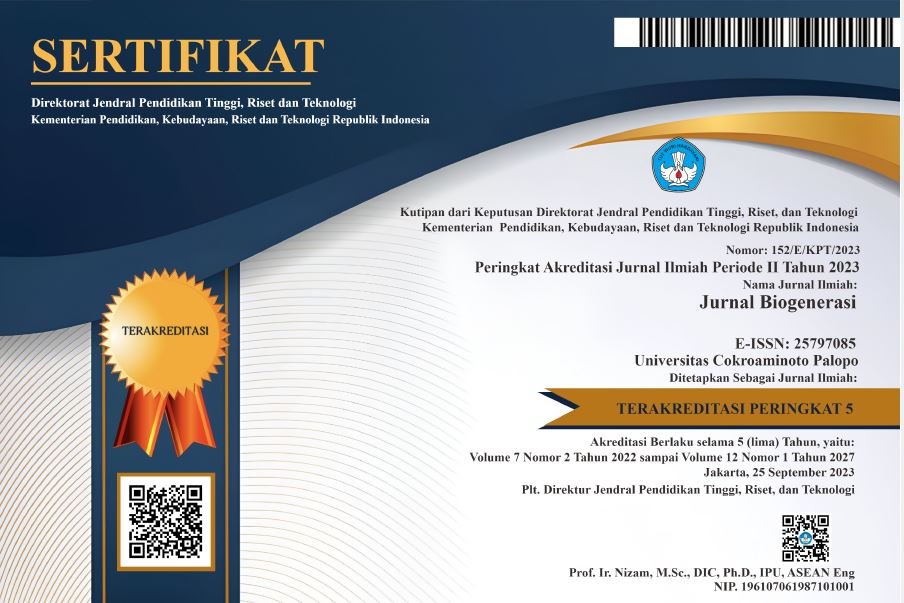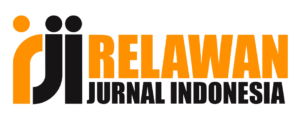ANALISIS BIBLIOMETRIK PERKEMBANGAN PENELITIAN MIKROPLASTIK PADA BIVALVIA
DOI:
https://doi.org/10.30605/biogenerasi.v9i1.3501Keywords:
microplastic, bivalveAbstract
This study examines the development trend of microplastics research in 2019 - 2024. The study aims to find out: (1) the development of the number of international publications on microplastics in the Science Direct database from 2019 -22024; (2) the number of core journals in international publications on microplastics; (3) types of articles in international publications on microplastics; (4) the development of international publications of research in the field of microplastics by subject/field; (5) Map of the development of international publications of research in the field of microplastics based on keywords (co-word). Data collection by searching through science direct with microplastic keywords in the period 2019 to 2024 using article titles, abstracts, and keywords. Data analysis for the development trends of international publications in the field of microplastics was analyzed using VosViewer software. The results showed that the development of growth in the field of microplastics between 2019 and 2024 indexed in Science Direct reached the highest peak in 2023, with the number of publications reaching 240 publications (25.67%). The journal Science of The Total Environment is a journal that published 821 international publications on microplastics. Furthermore, based on co-word analysis, the development of the instrumentation field can be grouped into 7 main clusters.
Downloads
References
2. Abdli, S. H. T., Lahbib, Y., Menif, N.T. 2017. The First Evaluation of Microplastics in Sediments from the Complex Lagoon-Channel of Bizerte (Northern Tunisia). Water Air Soil Pollut. p. 303-401.
3. Andrady AL. 2011. Miroplastic in the marine environment. Marine Pollution Bulletin. 62: 1596-1605.
4. Assis, T.I., Gonçalves, R.F., 2022. Valorization of food waste by anaerobic digestion: a bibliometric and systematic review focusing on optimization, J. Environ. Manag, 115763
5. Boukid, F. 2022. Smart food packaging: an umbrella review of scientific publications, Coatings 12
6. Can-Güven, E. Microplastics as emerging atmospheric pollutants: A review and bibliometric analysis. Air Qual. Atmos. Health 2021, 14, 203–215. [Google Scholar] [CrossRef]
7. Djalal, Muspirah., Wangdi, Jamyang Tashi., Dirpan, Andi., Bastian, Februadi., Latief, Rindam., Ainani, Andi Fadiah and Yolanda, Dewi Sisilia. 2022. Traditional Indonesian food: a bibliometric review from 2013-2022, Canrea J. Food Technol. Nutr. Culin. J. Vol 5 Issue 2.
8. Garrido-Romero, Manuel., Aguado, Roberto., Moral, Ana., Brindley, Celeste and Ballesteros, Mente. 2022. From traditional paper to nanocomposite films: analysis of global research into cellulose for food packaging. Journal Food Packaging and Shelf Life. Shelf Life Vol. 31.
9. Hardesty, B. D., Harari, J., Isobe, A., Lebreton, L., Maximenko, N., Potemra, J., van Sebille, E., Dick Vethaak, A., & Wilcox, C. 2017. Using numerical model simulations to improve the understanding of micro-plastic distribution and pathways in the marine environment. Frontiers in Marine Science, 4, 1–9.
10. Haward M. 2018. Plastic pollution of the world’s seas and oceans as a contemporary challenge in ocean govermance. Nat Commun. 9(667): 1-3.
11. Hendrickson ES. 2017. Microplastics in the surface water and sediments of western Lake Superior as determined via microscopy, PYR-SGC/MS, and FTIR [Tesis]. Minnesota (US) : University of Minnesota
12. Jambeck JR, Jenna R, Johnsen K. 2015. Citizen based litter and marine debris data collection and mapping. Computing in Science & Engineering 17 (4): 20–26.
13. Lippiat, S., Opfer, S., & Arthur, C. 2013. Marine debris monitoring and assessment: recommendations for monitoring debris trends in the marine environment.
14. Lusher, A., Hollman, P., & Mandoza-Hill, J. 2017. Microplastics in fisheries and aquaculture. In FAO Fisheries and Aquaculture Technical Paper, 615.
15. Manalu AA. 2017. Kelimpahan mikroplastik di Teluk Jakarta [tesis]. Bogor (ID): Institut Pertanian Bogor.
16. 15. Naji, Abolfazl., Nuri, Marzieh. and Vethaak, A. Dick. 2018. Microplastics contamination in molluscs from the northern part of the Persian Gulf. Journal of Environmental Pollution.
17. [NOAA] National Oceanic and Atmospheric Administration. 2013. Marine Debris Monitoring and Assessment. NOAA Technical Memorandum. Silver Sping (US): National Oceanic and Atmospheric Administation.
18. Rochman CM, Hoh E, Hentschel BT, Kaye S. 2013. Long-term field measurement of sorption of organic contaminants to five types of plastic pellets: Implications For Plastic Marine Debris. Environmental Science Technology. 47: 1646−1654.
19. Sari K. 2018. Keberadaan mikroplastik pada hewan filter feeder di padang lamun Kepulauan Spermonde Kota Makassar [skripsi]. Makassar (ID): Universitas Hasanuddin.
20. Storck, F. R., Karlsruhe, T., Kools, S. A. E., Institute, K. W. R., & Pfeiffer, S. R. 2015. Microplastics in Fresh Water Resources. Journal of Science Brief, 72 (5), 1455–1457.
21. Wong, S.L.; Nyakuma, B.B.; Wong, K.Y.; Lee, C.T.; Lee, T.H.; Lee, C.H. Microplastics and nanoplastics in global food webs: A bibliometric analysis (2009–2019). Mar. Pollut. Bull. 2020, 158, 111432.
22. Zhong, Meihui and Lin, Mingwei. 2022. Bibliometric analysis for economy in COVID-19 pandemic. Journal Heliyon Vol. 8 Issue 9.
Downloads
Published
How to Cite
Issue
Section
License
In submitting the manuscript to the journal, the authors certify that:
- They are authorized by their co-authors to enter into these arrangements.
- The work described has not been formally published before, except in the form of an abstract or as part of a published lecture, review, thesis, or overlay journal.
- That it is not under consideration for publication elsewhere,
- That its publication has been approved by all the author(s) and by the responsible authorities – tacitly or explicitly – of the institutes where the work has been carried out.
- They secure the right to reproduce any material that has already been published or copyrighted elsewhere.
- They agree to the following license and copyright agreement.
License and Copyright Agreement
Authors who publish with this journal agree to the following terms:
- Authors retain copyright and grant the journal right of first publication with the work simultaneously licensed under Creative Commons Attribution License (CC BY 4.0) that allows others to share the work with an acknowledgment of the work's authorship and initial publication in this journal.
- Authors are able to enter into separate, additional contractual arrangements for the non-exclusive distribution of the journal's published version of the work (e.g., post it to an institutional repository or publish it in a book), with an acknowledgment of its initial publication in this journal.
- Authors are permitted and encouraged to post their work online (e.g., in institutional repositories or on their website) prior to and during the submission process, as it can lead to productive exchanges, as well as earlier and greater citation of published work.


.png)

